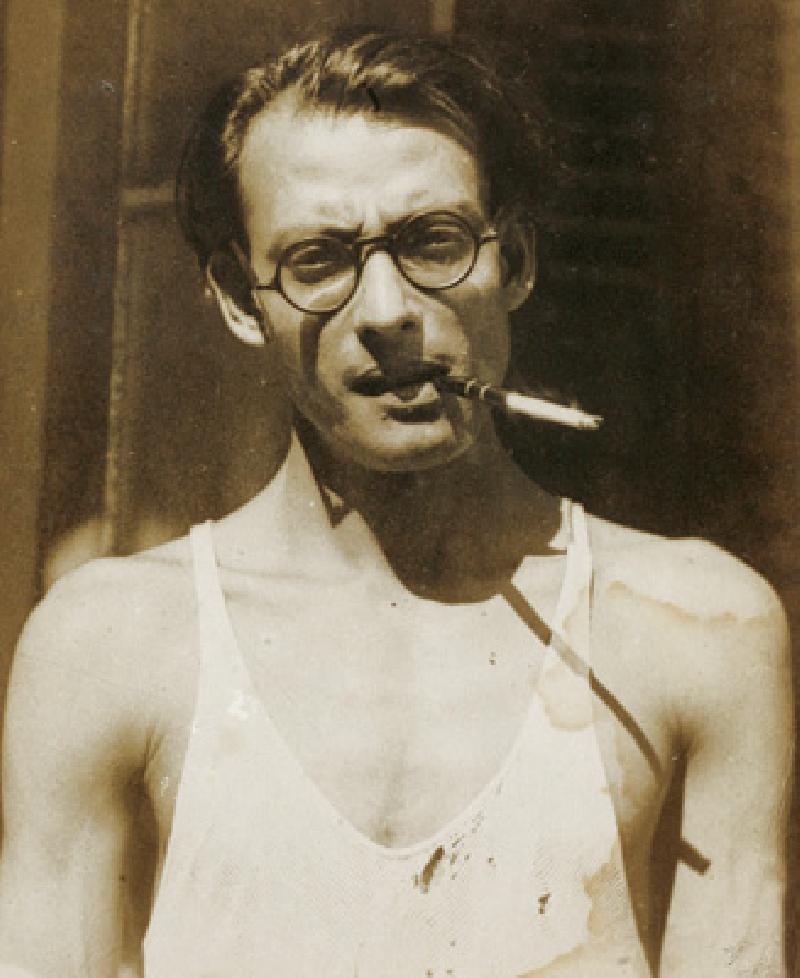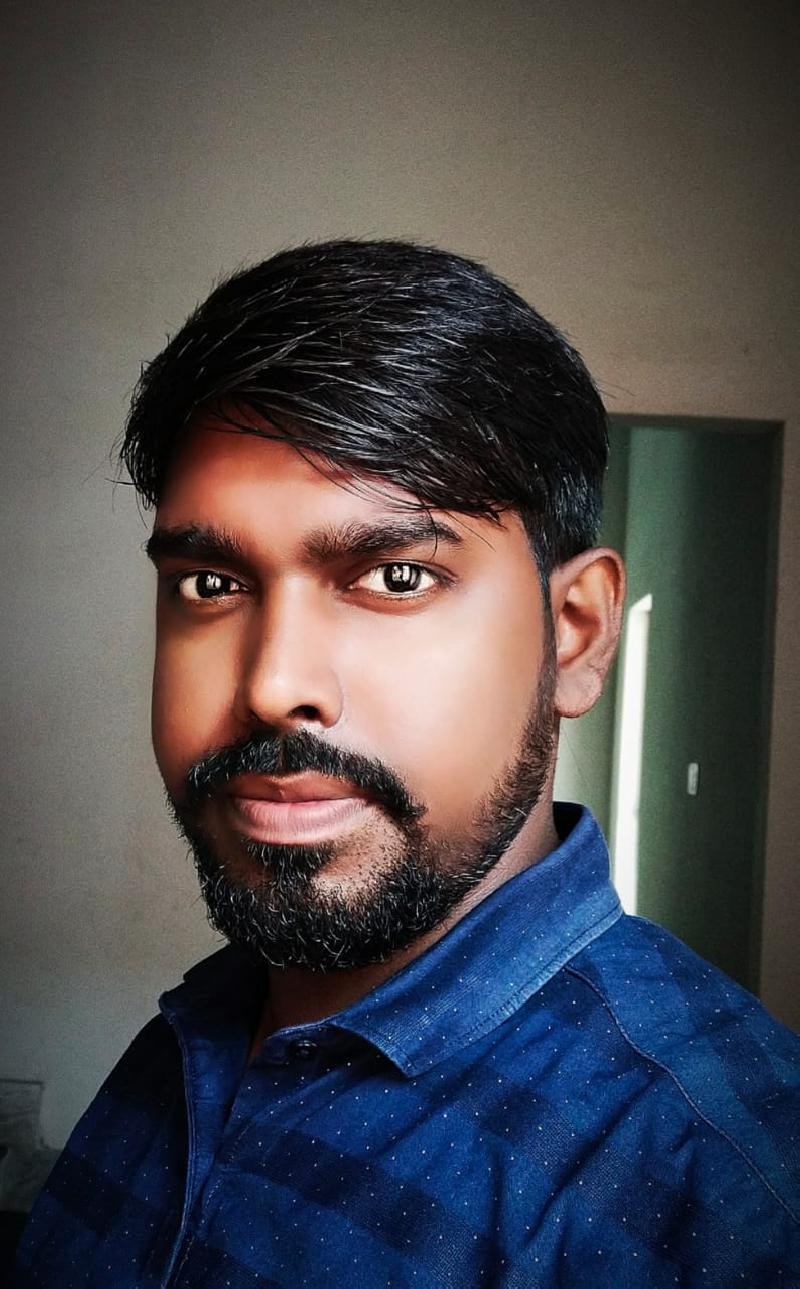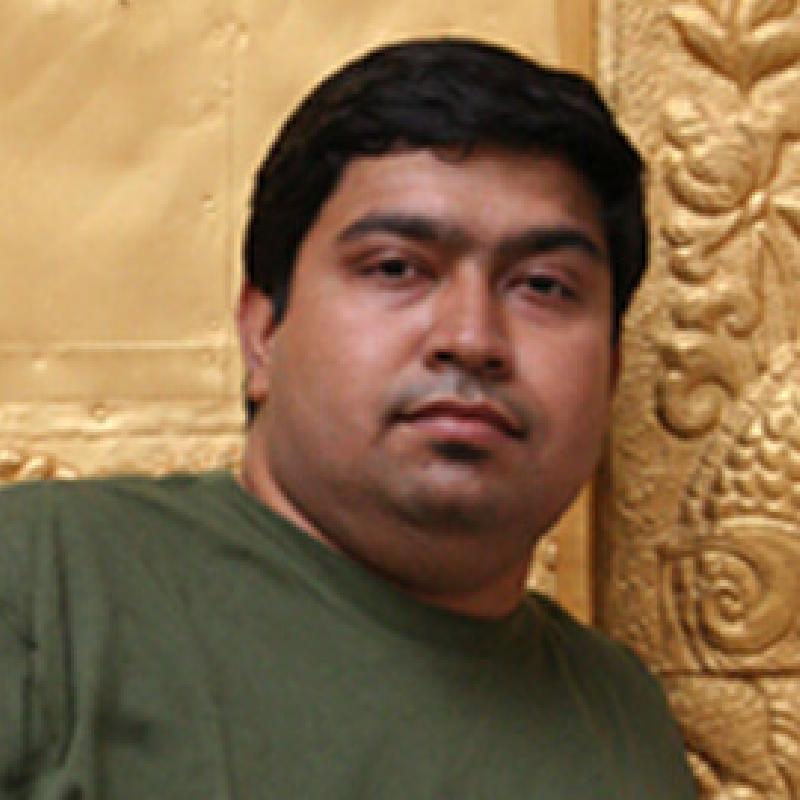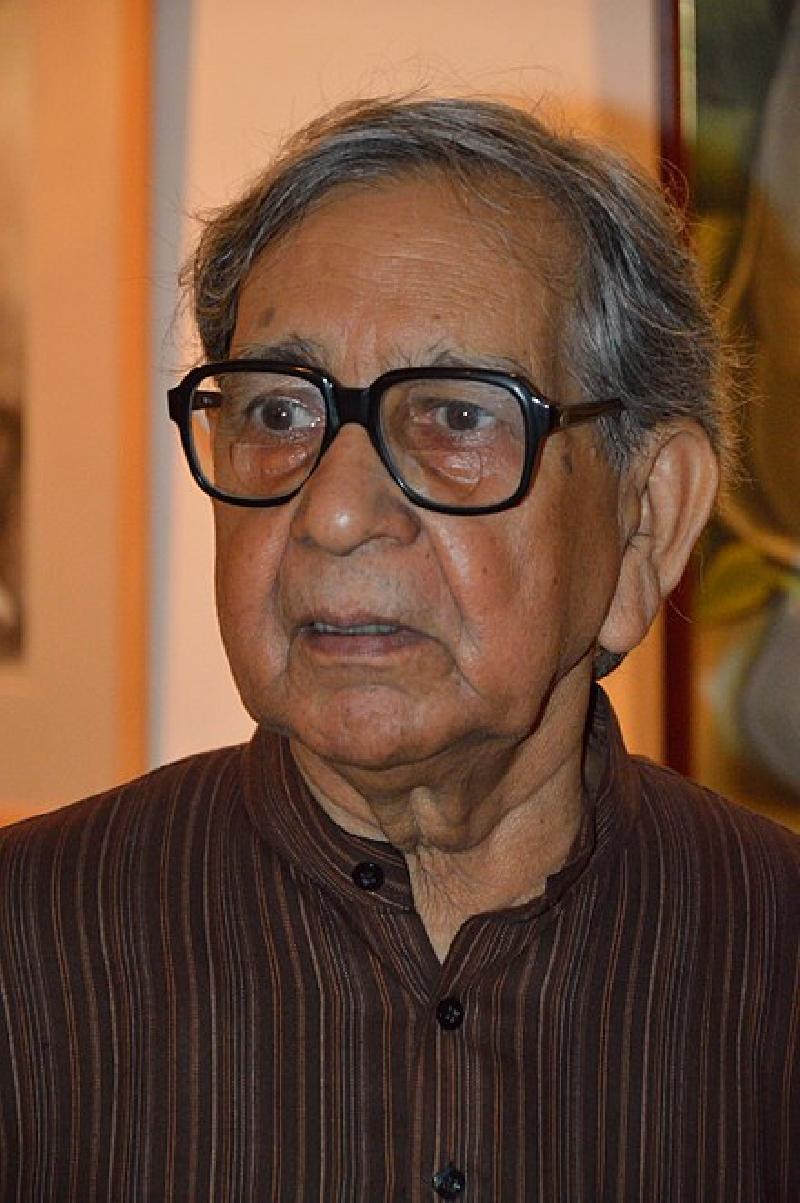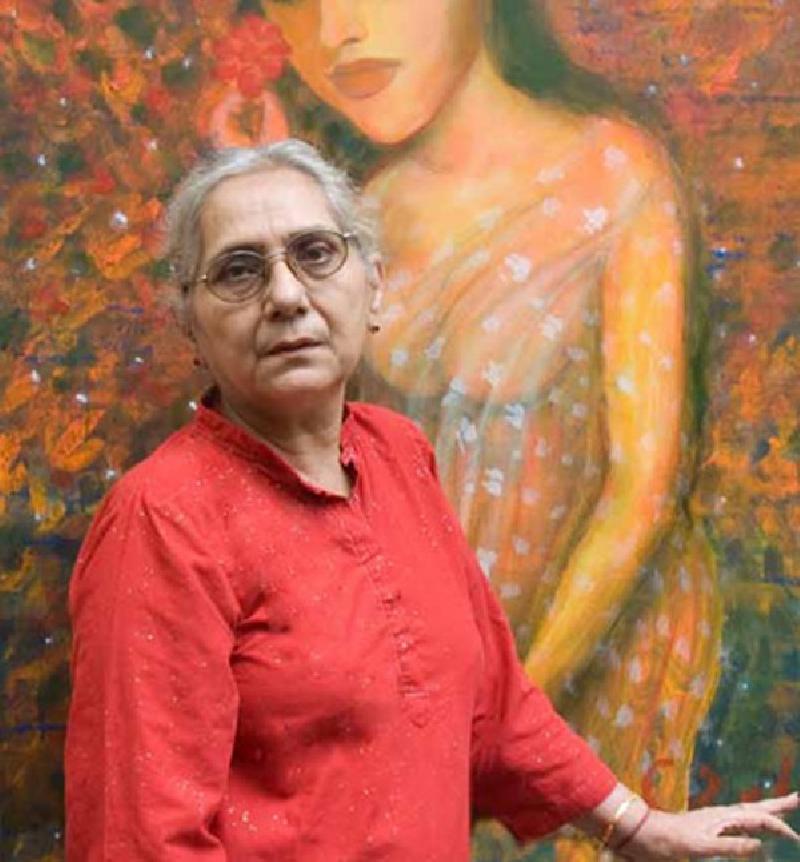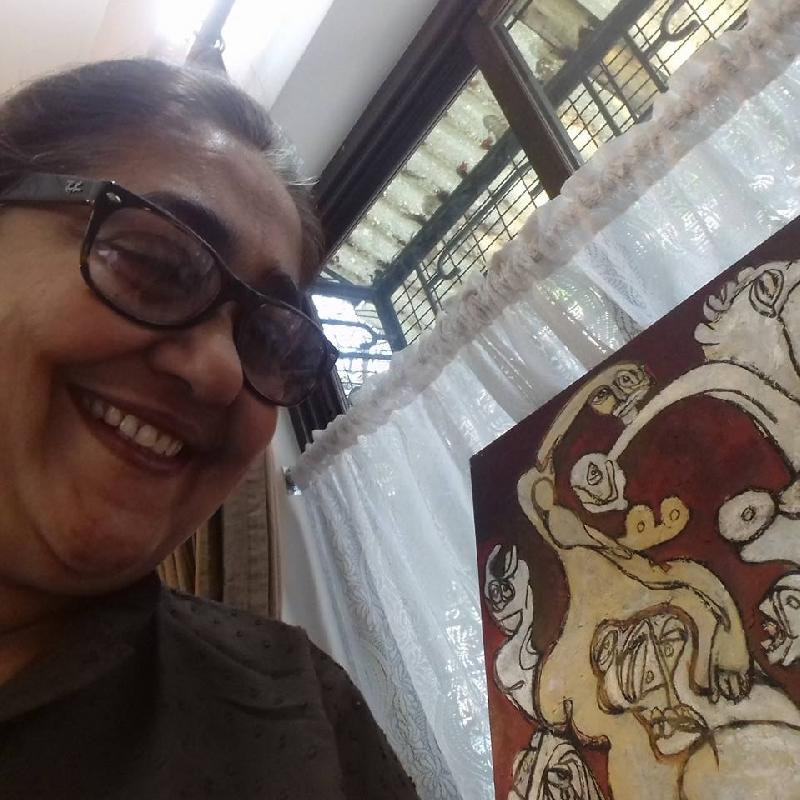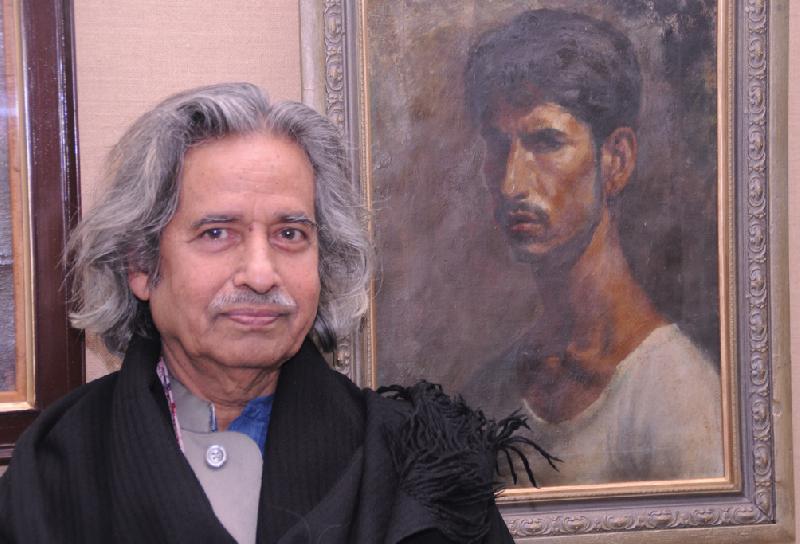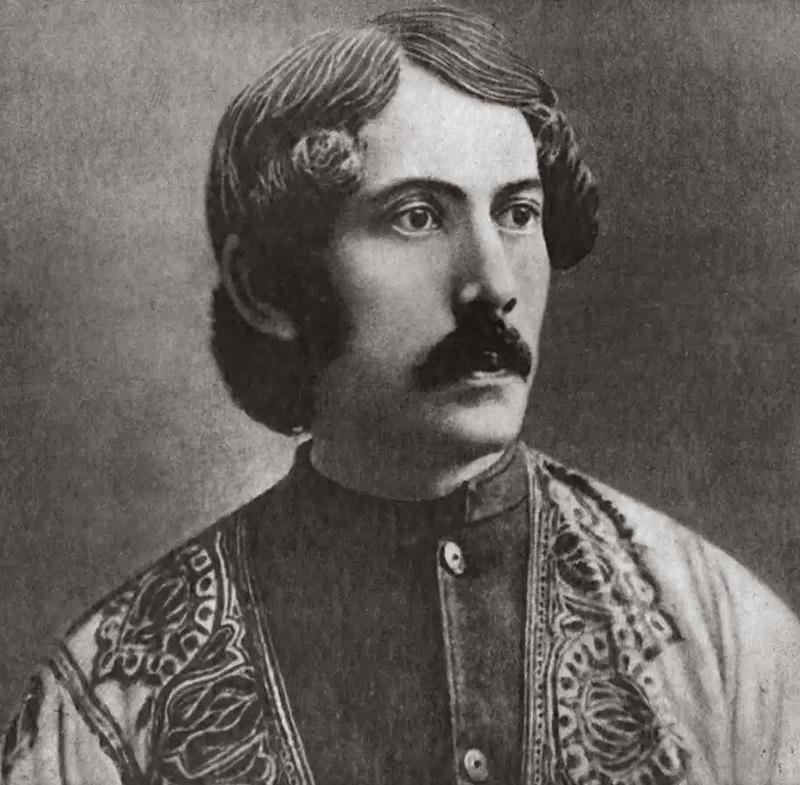Chittaprosad's Bhattacharya's works reflect his reformist concerns. They are a depiction of the images that were his preoccupation --- poor peasants and laborers. His hard-hitting caricatures and sketches of the poor dying in the Bengal famine (1943) worked like modern-day reportage and shook the middle class and the British officials out of their apathy.
His reformist concerns showed in his life too, when he refused to use his Brahminical surname 'Bhattacharyya'. Today, collectors and lovers of art treasure Chittaprosad's woodcuts, linocuts, and posters immensely.
Yet, this artist was once refused admission to the Government School of Art, Kolkata, and the Kala Bhawan, Santiniketan. A self-taught artist, he experimented constantly with the art of picture-making. A master of many forms, he quickly adapted to the needs of the times and switched to simpler lines and fewer exaggerations of forms.
A contemporary of Zainul Abedin (1917-1976, Bangladesh) and Govardhan Ash, who were known for their brutally honest depiction of human suffering, Chittoprasad was a Communist Party of India activist. Amongst his noted works are the posters and paintings of the Naval Mutiny in Bombay (1946). He even joined the World Peace Movement.
Bhattacharya first exhibited in Prague's National Gallery and was heralded bet the international artist community as a master. Confession, a documentary on his life by Pavel Hobl (Czech) won a special prize from the World Peace Council.
Bhattacharya passed away in 1978.
Dasarath Das was born on 3rd February 1989, in Murshidabad, West Bengal, India. He completed his B.F.A. - in 2012 (Printmaking) from renowned The Indian College of Arts And Draftsmanship (R.B.U.) Kolkata. And his M.F.A.-2014 (Printmaking) from the reputed Govt. College of Art & Craft, Kolkata (University of Calcutta) India. He has participated in his recent National exhibition, International exhibition shows, Scholarships, Group shows, awards and workshops, etc. Some of them are - Lalitkala Akademi (Delhi), Birla Academy Art and Culture (Kolkata), Academy of Fine Arts (Kolkata), Rajya Charukal (Kolkata), CIMA Award Show (Kolkata), Emami Chisel Art (Kolkata), Artspace Gallery (Kolkata), S.C.Z.C.C.(Nagpur), Open Window (Kolkata), I.C.A.D.(Kolkata), G.C.A.C (Kolkata), etc.
Debabrata De was born in 1959 in West Bengal. In 1989 he received his Diploma in Fine Arts from Indian College of Arts and Draftsmanship, Calcutta. Debabrata had several solo shows: In 1989 he showcased his solo at Tagore Art Gallery, Calcutta. In 1990 he had a solo show at the Academy of Fine Arts, Calcutta. In 1997 he exhibited solo at Rashtriya Lalit Kala Akademi, New Delhi. In 2006 he had a solo exhibition at the Colour& Brush Commercial Gallery, in Mumbai. In 2008 he showcased at Sanskriti Art Gallery, Kolkata. He participated in several group exhibitions: In 1989 he took part in a group show at the Academy of Fine Arts, Calcutta. In 1990 participated in group shows at Bajaj Art Gallery, Mumbai; at Jehangir Art Gallery, Mumbai and at Nehru Centre, Mumbai. In 1991 he took part in the Ganapathi Terracotta Exhibition at Chemould Art Gallery, Calcutta. In 1992 he participated in the Arts Acre Exhibition at Jehangir Art Gallery, Mumbai. In 1994 he exhibited in the 8th Triennial at Lalit Kala Academy, New Delhi. In 1995 he took part in a group show at Jehangir Art Gallery, in Mumbai. In 1995 and 1997 he participated in People for Animals at Park Hotel, New Delhi. In 1998 he took part in Contemporary Artists in India at RashtriyaLalit Kala Akademi, New Delhi. In 2000 he participated in BangaUtsav 2000 in Calcutta. In 2001 he participated in a group show at Art Indus, New Delhi. From 2007 to 2015 he participated in the annual exhibitions of Sanskriti Art Gallery, Kolkata. From 2011 – 2014 he took part in the annual exhibitions of Gallery Kolkata. From 2013 – 2015 he participated in the annual exhibitions of Gallery ICCI. From 2014 – 2015 he took part in group shows at Gitanjali Art Gallery, New Delhi. He took part in group exhibitions at Greenwich Citizen Art Gallery and Ipswich Art Gallery, U.K. In 2015 he took part in a group show at the Artist Center, Mumbai. In 2016 he participated in a group show at Jehangir Art Gallery, Mumbai. Debabrata has participated in several workshops: He took part in the Calcutta Artist workshop by Max Muller Bhavan. He participated in a Terracotta workshop at Arts Acre by Lalit Kala Academy. He took part in a Woodcut Print workshop by USIS Arts Acre. He participated in a Graphics workshop by Alliance Francaise. He took part in Calcutta Sculptors Camp in Jaipur. From 2013 to 2016 he took part in Gallery Sanskriti Art Workshop, Bishnupur. From 2006 – 2009 he took part in the Annual Exhibition at Sanskriti Art Gallery, Calcutta. He has received several awards: In 1997, 1998, and 2002 he received an award from AIFACS, New Delhi. Debabrata lives and works in Kolkata.
Farhad Hussain’s paintings are brimming with confidence in vibrant colors. A 2003 graduate from Shantiniketan, Hussain went on to complete his postgraduate diploma from the Faculty of Fine Arts, Baroda in 2005. His works are based on the realities of human relationships and their subtle complexities. While his earlier works were less complex the seed of his current work was sown then. Farhad says, “In my earlier works, I used to work on images that came from my day-to-day visual experience. But these images were always present with a touch of humor and sarcasm.” Farhad’s paintings dwell on the human figure. His works are narrative with each figure interrelated to the other. Though, at a glance, one may feel awestruck by their presence, each figure portrays an integral part of the work, which nurtures the narrative. In terms of structure and concepts, these recent works deal with more thought-provocative intricacies. The underlying sublimity of humor and irony betray the true experience of the artist. Vibrant colors and bright backdrops are a trademark of the artist. He has chosen to use tempera on cloth for his works, the media allowing him to achieve the desired vibrancy of colors. His work is the method of applying color: dot-by-dot till the entire area is completely covered. Various elements from miniature paintings, Kalighat paintings, Japanese prints, and images from mass media are scrutinized, transformed, and transferred onto the surface through the artist's style of expression. After recognizing his style, the artist is continuously striving to evolve his work, trying to take it to a higher aesthetic level. There is a conscious bid to make his presence felt through his artwork. He has received a Nasreen Mohamedi scholarship. The Indian Art College Art Exhibition also awarded him the prize for best watercolor in 1998. Farhad has participated in several group shows in Baroda, Mumbai and Kolkata.
Ganesh Haloi was born in 1936 in East Bengal, now in Bangladesh. He migrated to Kolkata during the partition. He graduated from the Government College of Art & craft Kolkata in 1956 and joined the Archaeological Survey of India as a Senior Artist. From 1957 to 1963 he was deputed to work at Ajanta Cave. Later, he joined Art College Kolkata as a lecturer in 1964. Earlier, his work included the study of miniatures at Banasthali (Rajasthan) and copying Ajanta frescoes for six long years. Initially, his work is dominated by landscapes, but formerly paintings reflect his introverted and philosophic temperament. Haloi's work shows his preoccupation with the theme of devastation or calamity and resilience. He tries to fit the irregular movements of life into the artificial boundaries of the paintings. His perspective is that of a victim but tempered with a strong dose of philosophy, a tranquil acceptance. His use of colors is thick, evoking thoughtful reminiscence with spontaneous ease. Ganesh Haloi has won several awards including the Late R. N. Chakraborty Memorial (ex-principal) Gold Medal from the Government College of Art, Kolkata (1956), the seven silver medals from Kolkata University (1953, 1954, 1955). Gold medals from the Academy of Fine Arts, Kolkata (1955, 1956, 1957, 1963, 1964, 1966, and 1970).
Gobardhan Ash was born in 1907 in India. He studied at the Fine Arts Government School of Arts in Kolkata between 1926 and 1930 and the Government School of Arts and Crafts in Chennai in 1932. He was nominated Chief Artist at the Indian Institute of Arts and Industry in Kolkata in 1946, In 1953, he became a Senior Teacher at the Indian Art School of Kolkata, where he stayed another two years, before founding the Fine Art Mission of Begumpur in 1956. He then started his career as an independent artist and remained so until he died in 1996. In modern Indian art, his contribution is remarkable. India witnessed the advent of Western modernism is significant and colossal. His work was exploratory, visionary, and inspiring. He printed with bold courage and a free spirit, never yielding to the rules set by official art. He rejected the preconceived notions of how an artist ought to render his subjects and inevitably rebelled against the academic rules. In 1945, Ash was brought into the public eye when the Progressive Writers Association discovered his series of paintings on the Bengal famine. The paintings depict, if not document, the ravages of the 1943 catastrophe. In juxtaposition to the famine series, his impressionist and post-impressionist gouaches during the late 40s come as an interesting antithesis. Colors, vibrant, come alive in a pulsating tone to dominate the entire painting.
Gogi Saroj Pal was born in 1945 in Neoli, Uttar Pradesh, India. Being an eminent Indian artist she works in many media, including gouache, oil, ceramic, and weaving. Her works are usually women-centric and many of her paintings have a fantastical element that still comments on the female condition. Her early works were more realistic, but over time she has moved to simpler, more stylized paintings that have considerable impact. She has a diploma in painting from the College of Art in Lucknow, Uttar Pradesh, India. Over the years she has had nearly 30 solo shows and won several awards including the National Award of the Lalit Kala Akademi. She also participated in a large number of group shows both in India and overseas: Yugoslavia, Germany, France, Cuba, and Japan among others. For two years, she studied at the College of Art in Banasthali, Rajasthan from 1961 to 1962 and then studied at the Government College of Arts and Crafts in Lucknow for a full 5 year graduate course. She chose painting as the main subject in the rigors of academic realism. She also did a full graduate course of art in the College of Art in Delhi in 1968. She realized early in life that she wanted to become an artist. Her uncle being a famous writer she was exposed to the literary world and the arts. Her family was skeptical about her becoming an artist as in that era there were very few artists and almost no female artists. She knew that to become an artist, she would have to enroll in an art school. According to the authors in the book- 'Gogi Saroj Pal: The Feminine Unbound', Gogi's women appeared to be feminine, sensuous, and coquettish but they could equally be bovine, obdurate, and slovenly. In the initial stages of her experimentation with her work and her early works in lithography in 1979, Bartholomew would sense the solitariness of her 'faces, portraits, images, children with legs crossed, arms folded, recumbent figures, groups of people staring quietly, privately, personally into some past or future
Gopal Ghosh was born in Kolkata in 1913. He obtained a Diploma in Painting from Maharaja School of Arts and Crafts, Jaipur (1931-35). Following this, he went on to pursue a Diploma in Sculpture at the Government College of Arts and Crafts, Madras where he was a student of D.P. Roychowdhury, who was known for his realistic style in paintings and sculptures. He is known the world over for his mastery of the medium of watercolor. He is often credited with raising the stature of watercolor within the genre of Indian art history. Ghose’s paintings are normally small in size, giving them a miniature quality with an impressionistic style. Nature was to him the primary and ultimate inspiration and he had an inexhaustible appetite for the painted landscape. Ghose's color sense was unique. He would occasionally mix two media such as watercolor and pastel; his palette favored gentle misty shades broken patches of sharp color. Ghose passed away in 1990. Some of his works made it to the prestigious collections of the country including the Birla Academy of Art & Culture, Kolkata, and the National Gallery of Modern Art, New Delhi.
Born in 1921 in Dinajpur - a small town in undivided Bengal, now in Bangladesh, Haren Das took a diploma in Fine Art from the Government College of Arts and Crafts, Kolkata. He specialized in graphic arts, besides studying mural painting.
Immediately after graduating in 1938, he joined as a lecturer in his alma mater. He also enrolled in a two-year teacher-training course, where he opted to study graphic art, woodcuts, lithography, and etchings. Das is considered to be one of the finest graphic artists India has ever produced, especially in woodcuts.
Das introduced line engraving and etching into the art curriculum of the Government College of Arts and Crafts, thus laying the foundation for printmaking and graphic art education in India. He once told an art writer, "Just as a poet or musician expresses his emotions and his interpretations of life through words and sounds, an artist visualizes the phenomenal world around him in the receptacle of his mind and expresses it in color and form. But an artist who is obsessed with woodcuts sees life through a special point of view and must work with light and shade, composing them into a picture and adapting his medium to the presentation."
Most of his works, especially his woodcuts and engravings, captured rural, pastoral Bengal. Despite using restraint and economy, Das has managed to offer a glimpse of a Bengal that no longer exists. Most of his work is a nostalgic reflection of a childhood and a youth spent at Dinajpur. In his works, the artist depicts man as part of nature, an individual who lives in harmony with the elements surrounding him. His works talk of cobbled streets, buffaloes, the village well, women with pots on their heads...
A winner of several national awards, Das held several one-man shows and group shows across India. His works are in the collections of the National Gallery of Modern Art, New Delhi, the Calcutta Art Gallery, and many other state galleries. In 1950, he published a book of engravings titled `Bengal Village in Wood`.
Haren Das died in Kolkata in 1968.
Born in 1887 in a small village in Beliatore, Bankura district, West Bengal, Jamini Roy joined the Government School of Art, Kolkata in 1903. He began his career by painting in the Post-Impressionist genre of landscapes and portraits, very much in keeping with his training in a British academic system. Yet, by 1925, Roy had begun experimenting along the lines of popular bazaar paintings sold outside the Kalighat temple in Kolkata. By the early 1930s, Roy made a complete switch to indigenous materials to paint on woven mats, cloth, and wood coated with lime. The inspiration for painting on woven mats was the textures he found in Byzantine art, which he had seen in color photographs. It occurred to him that painting on a woven mat might make for an interesting mosaic-like surface. The Santhals, a tribal people who live in the rural districts of Bengal, were an important subject for Roy. A series of works done a decade before World War II is a very good example of how he captured the qualities that are a part of native folk painting and recombined them with those of his own. He fused the minimal brush strokes of the Kalighat style with elements of tribal art from Bengal (like that of the terracotta work found in the Bishnupur temple in Bengal, where terracotta was often composed into decorative units - some elaborate in design - over portals and across exterior walls of the temples). Roy's rejection of the then-modern style of painting and his foray into the realm of Bengali folk paintings marked a new beginning in the history of Indian modern art. The mother and child, Radha, and animals were painted in simple two-dimensional forms, with flat color application and an emphasis on the lines. The main subjects were often enclosed within decorative borders with motifs in the background. The figure of Christ was also a subject that Roy often painted. Roy held several one-man exhibitions and numerous group shows. His works can be found in several private and public collections, institutions, and museums all over the world, including the Lalit Kala Academy in Delhi and museums in Germany and the United States of America. He was honored with the Padma Bhushan in 1955. Jamini Roy died on 24 April 1972 in Kolkata, where he had lived all his life.
According to a critic, "Jaya stands apart and single-mindedly continues to paint the kind of pictures that distinguishes her from being a mere performer. This is due to her commitment and serious approach to her work." More than any other thing that one can notice about Jaya is that she represents a generation that confronts contemporary art with individuality and daring. Her pictures bring into view her style and she has her imperatives. In the world of art, Jaya's work stands out for its obvious concern with the aesthetics in art rather than commercial success. She is rated as one of the top painters and front-runners of the Bengal art scene which has produced some of the country's finest talent. Powerful and enigmatic figures that brim with earthy energy, raw and powerful. Jaya works with broad and sure brush strokes done in a spectrum of rich colors. The sure color strokes stand out and her work evokes the feeling that the world is full of organic tones that seem to breathe with a life force of its own. The figures look massive and primitive, voluminous and these qualities give her figures a distinctive character. Dark men and women sitting in a closed world of their own seem to brood, looking into themselves with an enigmatic air. Her figures have structural compositional values and they seem to be full of tension and force. Jaya Ganguly asserts that she is not a hard-core feminist, but being a woman she looks at the world from a woman's point of view. Her work seems to be about men and women, as one cannot be without the other. Women from orthodox and bourgeoisie backgrounds, women who survive a monotonous and placid existence are a part of her pictures. They not only show women are oppressed, but also the men who live around them are suppressed with outdated beliefs, rituals, and conventions that bind the bourgeois society with high walls all around. The depth, intensity, and even wisdom of the ordinary subjects living ordinary lives in her paintings have been commented upon. Jaya attracts and repels at the same time, her figures are lethargic, unfathomable, and deep, victims and survivors. Her canvas radiates volumes of energy. Her color, line, form, and moving mass, are thick and voluminous figures. The physical energy felt with excessive overtone turns into primitive force. Jaya Ganguly's multiple laying of line and color is interesting. An element of surprise in her work is the quasi-abstract quality. Black and indigo add dynamism and highlight the work. Jaya says her paintings are a strand of thought. A product of the Indian Art College of Kolkata, she has had several shows in New Delhi, Mumbai, and Kolkata including the Festival of India in Sweden in 1987.
Jayashree Chakravarty was born in Tripura in 1956. She completed her bachelor's degree in fine arts from Viswa Bharati in the sprawling natural environment of Santiniketan. After that, she got her post-graduate diploma in Fine Arts from the MS University of Baroda where she was exposed to an urban sensibility. She was also an artist in residence at Aix en Provence from 1993-95, where she was influenced in the formative years of her practice by the French Movement. She spent her early days in Kolkata, in the proximity of hills and forests thereby coming across a variety of flora and fauna. Soon the township became a concrete jungle with few traces of natural past left behind. This influenced her paintings, where the old and new cityscapes are melded with fine expertise. She follows her art-making techniques, using organic material and varied kinds of papers, her installations in the form of paper scrolls remain unique in their conceptions and execution. In her works, she uses superimposed forms. She received the Gujarat Lalit Kala Akademi Award and the Second Bharat Bhavan Biennale Award in 1988.
Jogen Chowdhury is known for his ability to successfully marry traditional imagery with the zeitgeist of contemporary painting, in a skillful blend of an urbane self-awareness and a highly localized Bengali influence. His early works show an attention to figuration that carries through in his current pieces. In an interview, Chowdhury commented that, in his early works, "the space projected a simple iconic presence. A spatial sequence was worked out but the space was not complex. The background seemed to vanish." Anshuman Dasgupta describes these works as more iconic and more dramatized; per contra, Chowdhury describes his later works as "now more personalized and subtle". During his college days, Chowdhury took part in leftist literary circles, the members of which dismissed Rabindranath Tagore as a bourgeoisie and became interested in the works of Russian authors. But by and large, Chowdhury kept himself apart from cultural movements: though a friend of the members of the Hungry Generation, his imagery was drawn from his cultural background more than his intellectual milieu. Born in 1939 in Faridpur, Bengal, Chowdhury studied at the Government College of Art and Crafts, Kolkata, from 1955-60, followed by a stint at L'Ecole Nationale Superior des Beax-Arts, Paris, in 1965-57 on a French Government Scholarship. His recent solo exhibitions include 'A Calligraphy of Touch and Gaze', presented by Kalakriti Art Gallery at ICIA, Mumbai, in 2008; and ‘Abahoman: Flowing Life’ at Vadehra Art Gallery, New Delhi, in 2007. Chowdhury has also had solo exhibitions at Gajah Gallery, Singapore; Gallerie Foundation for Indian Artists, Amsterdam; and the Fine Art Resource, Berlin. In 1966, Chowdhury was awarded the Prix le France de la Jeune Peinture in Paris, and, in 1986, received an award at the Second Biennale of Havana, Cuba. He was presented the Kalidas Sanman by the Government of Madhya Pradesh in 2001, Banga Bivushan 2012.
A true Bengali poly-math, Jyotirindranath was all in one; a brilliant playwright, a musicologist, a lyricist, a composer, a painter, an editor, and a scholar. Born in Jorosanko, Calcutta, in the year 1849, Jyotirindranath was elder to the prodigy of the generation, Rabindranath Tagore. Jyotirindranath was home-schooled by his elder brother Hemendranath, when he began his education. He pursued Fine Arts and then gradually became drawn to the performance arts section of the stream. He pursued studying theatre and began to practice and stage plays that he wrote, at his family home, in Jorosanko. Jyotirindranath and Rabindranath’s cousin, Ganendranath, established the Jorasanko Natyasala in 1865. The first play that was staged there was not written by him. It was the celebrated play “Krishnakumari” by another stalwart of the time, Michael Madhusudan Dutta. Jyotirindranath’s taking part in the play in the role of Ahalyadevi, a brave queen, drew him closer to the stage, and ever since he had aspirations to become a playwright. His works include plays like Purubikram (1874), and Sarojini (1875) – both of which feature songs written by Nobelauriet Rabindranath— other than that, Ashrumati (Woman in tears, 1879), and Swapnamayi (Lady of Dream, 1882). Jyotirindranath moved to his elder brother Satyendranath’s Ahmedabad residence in 1867. He spent most of his time there learning to play the sitar and trained in his artistic practices, including learning to paint and draw. During this time, he produced around 2,000 sketches. These works by Jyotirindranath Tagore are preserved at Rabindra Bharati University. He also learned two languages, French and Indian. Jyotirindranath was a brilliant scholar and translator as well. While he spent his days with his elder brother in Ahmedabad, he completed translating several books, among which Shakespeare’s Julius Caesar and Marcus Aurelius’ Meditations were notable. He translated many other novels, as well as publications on plays, philosophy, and history. He translated from English and French to his mother tongue, Bengali. His language skills were impeccable, be it English French, or Bengali. Gradually he worked with many Sanskrit dramas as well and translated the works. Among them is Kalidasa’s Shakuntala which he translated from Sanskrit into Bengali. He was celebrated for his satire on social evils. Jyotirindranath is notable for another breakthrough work in Bengali literature, he founded the celebrated “Bharati” magazine with his brother Dwijendranath. He was a brilliant musicologist. He played the piano beautifully. He was especially skillful with playing harmonium, violin, and sitar. He was majorly responsible for Jorasanko’s musical atmosphere. He would always compose music to which his friend Akshay Chandra Chaudhuri would find the words and later on, his dear brother ‘Rabi’. Jyotirindranath once, from 1869 to 1888, held the position of the secretary of Adi Brahmo Samaj. He helped organize the Hindu Mela in Kolkata. He also wrote the opening song for the occasion, titled ‘Udbhodan,’ in 1868. Moreover, he was claimed to have instituted the secret society called Sanjibani Sabha in the year 1876. The nationalistic approach of the secret society was dedicated to the betterment of the country.
K G Subramanyan was prolific in his art. In his personal life, he is a quintessential writer, scholar, teacher, and art historian. He is someone who spans the spectrum of mediums from painting to pottery, weaving, and glass painting. He believed in the value of Indian traditions and incorporated folklore, myth, and local techniques and stories into his work. He was an inspiration to generations of students as a member of the Baroda M S Fine Arts Faculty. His focus there in later years was on terracotta and pottery. Subramanian was one of the leading artists who were part of India’s post-Independence search for identity through art. He was born in Kerala on 15 February 1924, He completed his Bachelor’s Degree in Economics from the Presidency College in Chennai. In 1948, he graduated from Kala Bhavan in Santiniketan, where he studied under the tutelage of Benode Behari Mukherjee, Nandalal Bose, and Ramkinkar Baij. In 1955, he received a British Council Research Fellowship to the Slade School of Art at the University of London. He has exhibited over fifty solo shows, including exhibitions by the Seagull Foundation for the Arts in collaboration with the Jehangir Art Gallery, Mumbai, and the Harrington Street Arts Centre, Kolkata.
K. Muralidharan (b.1954) An alumnus of the College of Arts & Crafts, Chennai (post Diploma in Painting), K. Muralidharan has over the years evolved a highly individual style of painting. His works are constantly in demand by art galleries and art lovers. He has been awarded multiple grants and scholarships: Govt. of India Cultural Fellowship – Senior; “Guest Artist” Glasgow School, Scotland; “Guest Artist Student” at the Stockholm College of Art, Sweden from Swedish Institute; Lalit Kala Akademi Research Grant; Govt. of India Young Artist Cultural Scholarship in Painting. He is the recipient of the National Award 1994, Tamil Nadu State Lalit Kala Akademi Award 1979 & ’86, Chitrakala Parishad, Bangalore, and Orissa Lalit Kala Akademi 1987. A participant in numerous art camps including Prof.Paul Lingren’s graphics camp in India China, Malaysia, and Thailand, he has also held solo shows. Muralidharan has taken part in several prestigious group shows such as VII Triennale India 1991, I & II Bharat Bhavan Biennale 1985/87, and National Exhibitions 1980-94, in India, Sweden, and Scotland. His paintings find a place in the collections of many important institutions like Lalit Kala Akademi, NGMA, and galleries and art lovers.

